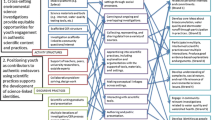Abstract
This chapter describes research exploring the STEM learning ecology, or the physical, social, and cultural contexts where the US public encounters science, technology, engineering, and math (STEM). It builds on previous research on the settings where structured formal learning occurs, primarily for children and youth. We focus on the role of zoos and aquariums within the ecology to identify how these two types of institutions provide distinct STEM experiences from each other and from others in the learning ecology. For the STEM enterprise, we highlight that the public encounters all four STEM disciplines equally often, dismantling science’s apparent hegemony in research and practice around public engagement. For researchers and practitioners in informal learning, we consider what “STEM learning” means for lay people and how it informs aspects of their personal, social, and professional selves. We end with recommendations for zoo and aquarium leadership to prioritize and support STEM learning by incorporating all STEM disciplines into programming and contributing to field-wide and institutional discourse on advancing public STEM learning. We underscore the potential for democratic participation in STEM through these experiences in myriad settings in their daily lives, regardless of their personal interest or affinity towards the specific disciplines.
Access this chapter
Tax calculation will be finalised at checkout
Purchases are for personal use only
Similar content being viewed by others
References
Allen, S., & Peterman, K. (2019). Evaluating informal STEM education: Issues and challenges in context. In A. C. Fu, A. Kannan, & R. J. Shavelson (Eds.), Evaluation in informal science, technology, engineering, and mathematics education. New directions for evaluation (Vol. 161, pp. 17–33).
Bevan, B. (2016). STEM learning ecologies: Relevant, responsive, and connected. Connected Science Learning, 1. Available 23 June 2016 from http://csl.nsta.org/2016/03/stem-learning-ecologies/
Falk, J. H. (2005). Free-choice environmental learning: Framing the discussion. Environmental Education Research, 11(3), 265–280.
Fraser, J., Weiss, M., Sheppard, B., & Flinner, K. (2013). Science center and zoos: Creating public value through complementary strengths. Dimension, (July–Aug 2013), 47–50.
Friedman, A. (Ed.). (2008). Framework for evaluating impacts of informal science education projects [On-line]. Available at http://insci.org/resources/Eval_Framework.pdf
Gardner, H. (1993). Multiple intelligences: The theory in practice. Basic Books.
Gupta, R., & Plemons, K. (2012). Volunteer perceptions of public value from a co-hosted museum-zoo exhibition. The Informal Learning Review, 118, 11–15.
Gupta, R., Fraser, J., Rank, S., Brucker, J., & Flinner, K. (2019). Multi-site case studies about zoo and aquarium visitors’ perceptions of the STEM learning ecology. Visitor Studies, 22, 127–146. https://doi.org/10.1080/10645578.2019.1661737
Gupta, R., Voiklis, J., Rank, S. J., Dwyer, J. D. L. T., Fraser, J., Flinner, K., & Nock, K. (2020). Public perceptions of the STEM learning ecology–perspectives from a national sample in the US. International Journal of Science Education, Part B, 10, 1–15.
Heimlich, J. E. (1993). Nonformal environmental education: Toward a working definition. The environmental outlook. ERIC/CSMEE Informational Bulletin.
Heimlich, J. E., & Falk, J. H. (2009). Free-choice learning and the environment. In J. H. Falk, J. E. Heimlich, & S. Foutz (Eds.), Free-choice learning and the environment (pp. 11–21). Alta Mira Press.
Heimlich, J. E., & Horr, E. E. T. (2010). Adult learning in free-choice, environmental settings: What makes it different? New Directions for Adult and Continuing Education, 2010(127), 57–66.
Melber, L. M., & Brown, K. D. (2008). Not like a regular science class: Informal science education for students with disabilities. The Clearing House, 82(1), 35–39.
Mocker, D. W., & Spear, G. E. (1982). Lifelong learning: Formal, nonformal, informal, and self-directed (Information series no. 241). National Institute of Education.
Reich, C., Price, J., Rubin, E., & Steiner, M. (2010). Inclusion, disabilities, and informal science learning. A CAISE Inquiry Group Report. Centre for Advancement of Informal Science Education (CAISE).
Traphagen, K., & Traill, S. (2014). Working paper: How cross-sector collaboration are advancing STEM learning. Noyce Foundation.
United States Census Bureau. (2016). Annual estimates of the resident population by sex, race, and hispanic origin for the United States, States, and Counties: April 1, 2010 to July 1, 2016 [Data file]. Retrieved from https://factfinder.census.gov/faces/tableservices/jsf/pages/productview.xhtml?src=bkmk
Acknowledgements
This research was supported by National Science Foundation Grant (#DRK-1612729 & #DRK-1612699). The authors are solely responsible for the content in this publication.
Author information
Authors and Affiliations
Editor information
Editors and Affiliations
Rights and permissions
Copyright information
© 2023 The Author(s), under exclusive license to Springer Nature Switzerland AG
About this chapter
Cite this chapter
Gupta, R., Voiklis, J., de la Torre Dwyer, J., Flinner, K., Fraser, J., Thomas, U.G. (2023). What Is the STEM Learning Ecology and Where Do Zoos and Aquariums Fit in It? Insights from National Studies of the Public’s Engagement with Science, Technology, Engineering, and Math. In: Fraser, J., Heimlich, J.E., Riedinger, K. (eds) Zoos and Aquariums in the Public Mind. Psychology and Our Planet. Springer, Cham. https://doi.org/10.1007/978-3-030-84942-9_5
Download citation
DOI: https://doi.org/10.1007/978-3-030-84942-9_5
Published:
Publisher Name: Springer, Cham
Print ISBN: 978-3-030-84941-2
Online ISBN: 978-3-030-84942-9
eBook Packages: Behavioral Science and PsychologyBehavioral Science and Psychology (R0)




